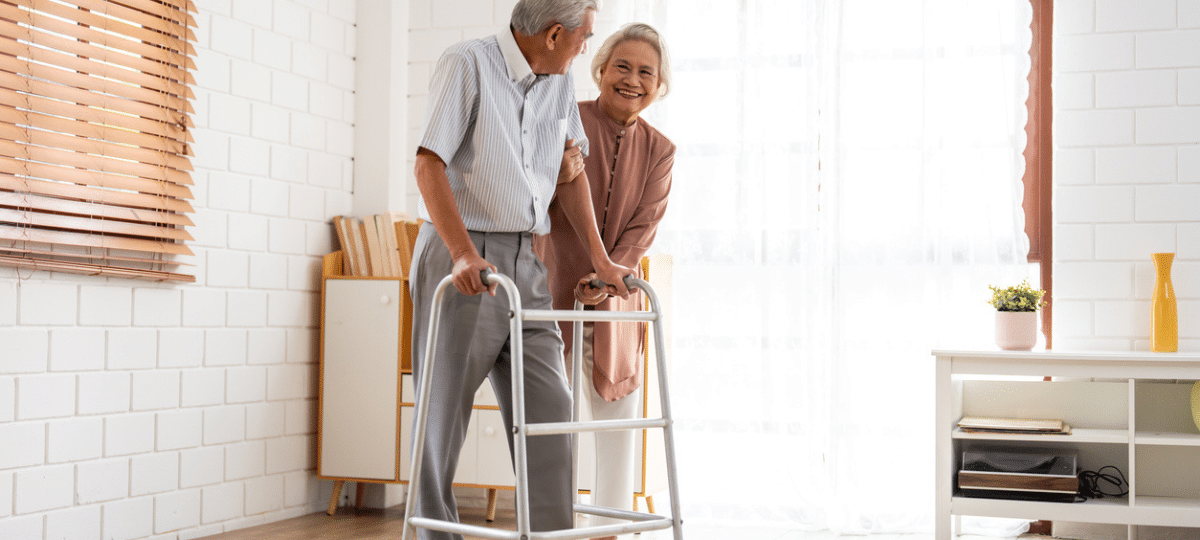Parkinson’s disease (PD) is a brain disorder that leads to problems with movement, muscle control, and balance. The disease involves a reduction in dopamine, a brain chemical involved in movement. Hallmark symptoms include tremors, stiff limbs, difficulty walking, and speech changes.
There’s no cure for PD, but current therapies focus on medicines to restore dopamine and physical exercise to improve motor symptoms.
According to the National Parkinson Foundation, a significant number of falls with injury happen in the PD patient’s home, especially in the bathroom. Although PD is a progressive disease, these falls can happen early in the course of the disease, when changes creep up on a person. Falls are a significant risk as the disease advances and a patient is shaky and walks with great difficulty.
Here are everyday living activities that pose challenges to PD patients and devices to help them navigate the challenges.
Walking
Trouble with balancing and walking is often the most frustrating symptom of PD. In later stages, people develop the so-called Parkinson’s gait where they take small, shuffling steps. Some devices and strategies that help PD patients:
- Canes and Walkers: Straight canes work better than tripods or quad canes. Choose one with the proper height to support your posture. That goes for walkers, too. A four-wheeled walker can better stabilize you than a lifting walker. For late-stage PD, a wheelchair or electric scooter is a good option.
- Metronome: Research shows improvement in gait if you practice walking to the beat of a metronome and if you visualize yourself taking long strides—the visualization draws on areas of the brain that can bolster the brain region responsible for movement.
- Medical Alert System: Since PD patients are at a higher risk of falls, a Medical Alert system can be an important safety tool. With the simple push of a button, you can summon an emergency responder. If you elect to add fall detection, the device will contact an operator for you in the event you are unable to push the button.
Eating
Eating is easier for PD patients, thanks to innovative assistive devices that help with independence and the joy of mealtime in a familiar way. Devices include:
- Utensils: Weighted, ergonomically-designed utensils by KEaterly minimize handshaking and lead to more successful eating. Utensils by Liftware use technology to stabilize tremors and force utensils to stay level.
- Knives: Cutting your favorite cheeseburger is still possible with the Rocker Knife. Its T-handle cuts food with a rocking motion; minimal dexterity is required.
- Dishes: Dishes are available that have non-skid feet that grip the table and a high-backed wall, allowing folks to scoop up their food. Gripware Round Scoop dish is one example.
Getting Dressed
Getting dressed is also made easier these days with companies designing clothing geared for PD patients. Examples include:
- Magnetic Buttons: The company MagnaReady offers sophisticated-looking dress shirts and pants for men featuring “buttons” that fasten through magnets on the inside.
- Button Aid and Zipper Pull: Performance Health/Patterson Medical offers a tool called the Weighted Button Aid that does the work for you—it pulls buttons through holes. Combination products, such as the Button Aid and Zipper Pull, feature a button aid and also a hook for pulling zippers.
- Zipper Rings: Oversized zipper rings are also available that allow PD patients to easily hold and pull zipper tabs. You simply attach these rings to your clothes.
- Velcro Shows: Shoes that fasten with Velcro work well for PD patients. Also, long-handled shoehorns are available for regular slip-on shoes.
Going to the Bathroom
Navigating the bathroom successfully and safely depends on putting modifications in place. Bathroom assistive devices are available through local trusted companies like Connecticut Surgical Supply or through national distributors like Performance Health/Patterson Medical and include:
- walk-in shower (preferable to a bath for PD patients)
- shower chair
- mounting bars or handrails in the shower (or tub) and near the toilet. The Versaframe offers armrests to support you when you use the toilet
- non-skid rubber bath mats in the shower (or tub)
- faucets that require only a touch to turn on
- motion-activated nightlights
Also, consider wood or linoleum floors, which are safer, and remove loose rugs. Remove threshold strips between rooms in your house as well.
Grooming
Occupational therapists offer tips for PD patients who may need to alter their routines slightly:
- use an electric toothbrush and an electric razor
- consider sitting on a chair in your bedroom and looking into a stand-up mirror on top of your bureau when brushing your hair or putting on makeup. You can use light wrist weights to slow and decrease your tremor.




